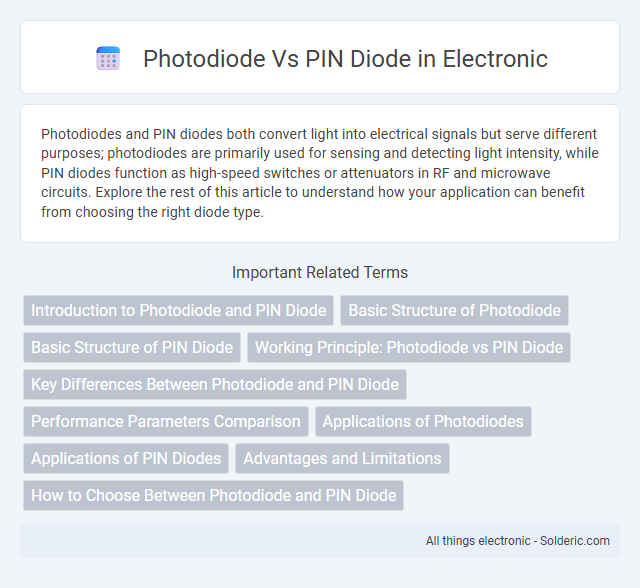Photodiodes and PIN diodes both convert light into electrical signals but serve different purposes; photodiodes are primarily used for sensing and detecting light intensity, while PIN diodes function as high-speed switches or attenuators in RF and microwave circuits. Explore the rest of this article to understand how your application can benefit from choosing the right diode type.
Comparison Table
| Feature | Photodiode | PIN Diode |
|---|---|---|
| Primary Function | Converts light into electrical current | High-frequency signal switching and attenuation |
| Structure | P-N junction diode sensitive to light | P-type, Intrinsic, N-type layers (PIN) |
| Operation Principle | Generates photocurrent proportional to light intensity | Variable resistance controlled by carrier injection |
| Application | Optical communication, light sensing | RF switching, attenuators, photodetectors |
| Response Speed | Fast response to light signals | High-speed RF switching capability |
| Biasing | Reverse biased for photodetection | Forward biased for conductivity control |
| Sensitivity | High optical sensitivity | Low optical sensitivity |
| Typical Usage | Light sensors, solar cells | RF circuits, attenuators |
Introduction to Photodiode and PIN Diode
Photodiodes are semiconductor devices that convert light into electrical current, essential for detecting and measuring light intensity in optical applications. PIN diodes feature an intrinsic layer between the p-type and n-type regions, providing improved response speed and efficiency in high-frequency and photodetection environments. Your choice between a photodiode and a PIN diode depends on factors like sensitivity, speed, and application requirements.
Basic Structure of Photodiode
The basic structure of a photodiode consists of a p-n junction designed to convert light into electrical current, optimized for high-speed and low-noise operation. A PIN diode incorporates an intrinsic (undoped) layer between the p-type and n-type regions, which significantly increases the depletion region, allowing for greater photodetection efficiency and faster response times. Your choice between a standard photodiode and a PIN diode depends on the required sensitivity and speed for applications such as optical communication or sensing.
Basic Structure of PIN Diode
The basic structure of a PIN diode consists of three layers: a P-type semiconductor, an intrinsic (undoped) layer, and an N-type semiconductor, creating a wide depletion region that enhances its high-frequency and switching performance. In comparison, a photodiode typically features a PIN structure to optimize light absorption and convert photons into electrical signals efficiently. The intrinsic layer in both devices plays a crucial role in improving carrier transport and response time, making PIN diodes highly suitable for high-speed and high-frequency applications.
Working Principle: Photodiode vs PIN Diode
Photodiodes operate by converting light into electrical current through the photoelectric effect, where photons generate electron-hole pairs in the depletion region of a p-n junction. PIN diodes contain an intrinsic (undoped) layer between the p-type and n-type regions, which extends the depletion region and enhances their ability to handle high-frequency signals and provide low capacitance. The intrinsic layer in PIN diodes improves their photoresponse and switching speed compared to standard photodiodes, making them suitable for high-speed optical communication and RF applications.
Key Differences Between Photodiode and PIN Diode
Photodiodes are semiconductor devices designed to convert light into electrical current, primarily used in optical sensing and communication systems. PIN diodes feature an intrinsic layer between p-type and n-type regions, optimizing them for high-frequency RF switching, photodetection, and power control applications. The key difference lies in their structural design and function: photodiodes emphasize light detection efficiency and speed, while PIN diodes combine photodetection with improved reverse bias capability for use in RF and optical circuits.
Performance Parameters Comparison
Photodiodes and PIN diodes differ significantly in performance parameters such as responsivity, response time, and noise levels. Photodiodes excel in high-speed light detection with faster response times and higher sensitivity, while PIN diodes offer lower dark current and better linearity for RF and switching applications. Understanding your specific requirements for speed, sensitivity, and noise can help determine whether a photodiode or PIN diode is better suited for your application.
Applications of Photodiodes
Photodiodes are widely used in optical communication systems, light meters, and medical devices due to their ability to convert light into electrical signals with high sensitivity. Unlike PIN diodes, which are primarily designed for high-frequency switching and photodetection with enhanced speed and linearity, photodiodes excel in applications requiring precise light measurement and detection. Understanding these distinctions helps you select the optimal diode for your optical sensing or imaging needs.
Applications of PIN Diodes
PIN diodes are widely utilized in high-frequency and RF switching applications due to their ability to act as variable resistors under different bias conditions. They are essential components in attenuators, photodetectors, and RF switches, providing low distortion and fast switching speeds. In optical communication systems, PIN diodes serve as efficient photodetectors, converting light signals into electrical currents with improved sensitivity compared to conventional photodiodes.
Advantages and Limitations
Photodiodes offer high sensitivity and fast response times, making them ideal for low-light applications and precise optical detection, while PIN diodes provide a wider dynamic range and better noise performance suitable for high-frequency and high-power applications. Photodiodes are limited by lower signal handling capacity and higher noise levels compared to PIN diodes, which require higher bias voltages and have slower switching speeds. PIN diodes excel in RF switching and optical communication systems but may introduce complexity in circuit design due to their specialized structure.
How to Choose Between Photodiode and PIN Diode
Choosing between a photodiode and a PIN diode depends primarily on the application's requirements for speed and sensitivity. Photodiodes are ideal for low-light detection and optical communication due to their high sensitivity and ability to convert light into electrical signals efficiently. PIN diodes excel in high-frequency applications such as RF switches and attenuators, offering faster response times and higher power handling capability.
Photodiode vs PIN diode Infographic

 solderic.com
solderic.com